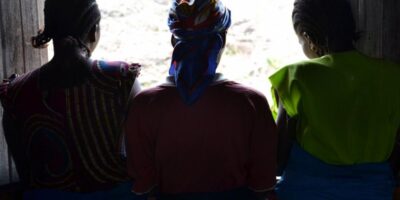« It’s very rare for us to observe such temperatures in Port-au-Prince, » meteorologist Rudolph Homère Victor tells AyiboPost
Throughout the month of February this year, D. Joseph still remembers the unusually cold evenings, the cool draughts that seeped into her room, leaving her freezing despite her thick blankets.
« These bouts forced me to change my bathing habits, » the young woman tells AyiboPost.
In fact, more than a dozen cold fronts swept through Haiti from November to February. According to meteorologist Rudolph Homère Victor, the temperature sometimes dropped to 17°C.
« It’s very rare for us to observe such temperatures in Port-au-Prince, » affirms the specialist.
In fact, more than a dozen cold fronts swept through Haiti from November to February.
Typically, the cold fronts remain above the North Coast. But this year, they reached much lower latitudes, Marcelin Esterlin, general coordinator of Haiti’s Hydrometeorological Unit (UHM), revealed to AyiboPost.
« Previously, they fluctuated between 20 and 23°C. This time, they dropped so low that they impacted the entire country, » Esterlin continues.
A cold front is a boundary between warm and cold air masses. When they meet, the colder, denser, and heavier air mass sinks beneath the warmer air mass, forcing it to rise into the atmosphere.
Clouds, precipitation, and sometimes storms accompany cold fronts, causing a drop in temperature and an increase in atmospheric pressure. These fronts can last 2 or 3 days, according to specialists.
Read also : The air in P-au-P can make you sick. Here are the areas at risk.
In Delmas, where she resides, D. Joseph describes to AyiboPost the changes in her habits and how she adapted to the cool temperatures of the capital.
« I went nearly2 days without bathing. I just settled for sponging a few essential areas with a towel, » she emphasizes, wryly.
After 3 days, finding her situation rather uncomfortable, D. Joseph finally opted for hot baths as a last resort.
Previously, they fluctuated between 20 and 23°C. This time, they dropped so low that they impacted the entire country.
Pyram Steevenson, 25, also experienced these cold spells.
« Though many think I do well with the cold, I had to change my shower regimen. I only bathed once a day, » he confides.
Living in Gonaïves, Pyram explains that, in February, his mother was sometimes forced to wear long-sleeved shirts, while his brother and sister opted for sweaters.
Lire aussi : El Niño attaque les paysans en Haïti
The cold fronts usually begins in November when polar air masses move from Greenland and the poles toward North America, ending in March, explains Marcelin Esterlin.
« Since Haiti is located below North America, about 1,000 kilometers from Miami, these cold air masses affect us, » explains the meteorologist.
However, something has changed.
« Due to climate change, these cold fronts are descending much lower and affecting us more, » Esterlin adds.
Haiti has a hot and humid tropical climate. The monthly maximum and minimum averages are 29.1°C and 18.5°C, respectively, with an average rainfall of 1,545 mm.
The cold front period usually begins in November when polar air masses move from Greenland and the poles toward North America, ending in March.
The country has several microclimates due to its morphological characteristics and variations in rainfall and temperature, according to data from the National Climate Change Adaptation Plan (PNA), established by the Ministry of Environment (ME) in 2023.
The country, like many others in the world, is affected by the vagaries of climate change.
Although he does not affirm that Haiti is experiencing severe climate disruptions, Kénel Délisca, a doctor in physical geography and climate specialist, affirms that, according to his analyses, the country’s temperature has increased compared to the 1971-2000 climatic norm.
« In the last two decades, the temperature has increased by about 1°C compared to the 1971-2000 reference period. These decades are much warmer than the previous 30 years, » analyzes Esterlin.
Lire aussi : Haïti sous les griffes des changements climatiques
Defined by the World Meteorological Organization (WMO), climatological normals (or climate normals) are the arithmetic average calculated for each month of the year from climatic data recorded over a 30-year period.
The Hydrometeorological Unit of Haiti (UHM), created in 2015 following the merging of the National Center for Meteorology (CNM) and the National Service for Water Resources (SNRE), is responsible for monitoring, observing, and forecasting weather in Haiti, under the Ministry of Agriculture, Natural Resources, and Rural Development (MARNDR).
In the last two decades, the temperature has increased by about 1°C compared to the 1971-2000 reference period. These are decades much warmer than the previous 30 years.
However, according to Marcelin Esterlin, the institution’s general coordinator since 2018, serious structural deficiencies and a lack of financial means prevent them from fulfilling their mission.
« To date, the state has never allocated sufficient funds to allow the institution to conduct regular data collection campaigns in Haiti, » reveals Esterlin to AyiboPost. « Apart from salaries, the state contributes absolutely nothing. »
Marcelin adds that even for office supplies, the institution has to submit requests to the Ministry of Agriculture, which can take 3 to 4 months to be fulfilled.
« Sometimes, we are forced to seek the support of non-governmental organizations, » he laments.
Meteorological data allows for, among other things, the scaling of public infrastructure such as bridges or roads, the establishment of forecasting models, and the study of atmospheric behavior and climate change.
To date, the state has never allocated sufficient funds to allow the institution to conduct regular data collection campaigns in Haiti.
Stations equipped to measure pressure, humidity, and rainfall have been installed in several cities around the country, including Cap-Haïtien, Jérémie, Jacmel, Les Cayes, and some communes of Port-au-Prince. However, recurrent maintenance problems have seriously compromised daily data collection, according to the coordinator.
« These recurring gaps hinder our ability to analyze the climate with certainty, scientifically and technically, » regrets Esterlin.
The insecurity prevailing in the country also affects the state organism. Employees residing in provincial towns have abandoned their positions due to roads blocked by gangs. Out of 59 employees, only 46 are still in position today, including only 4 meteorologists and the institution’s general coordinator.
Cover image: A woman who is cold covers herself with an appropriate sheet in her bed. | © freepik
Stay in touch with AyiboPost through :
► Our WhatsApp channel : click here
► Our WhatsApp Community : click here
► Our Telegram canal : click here







Comments